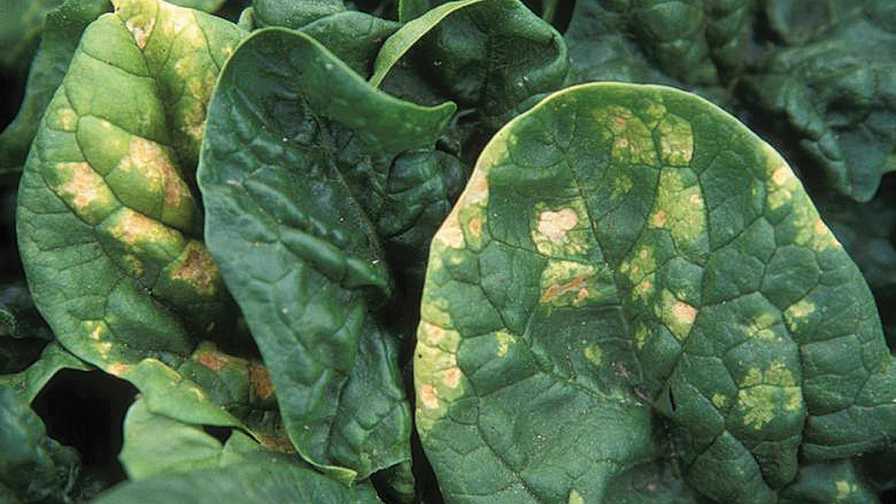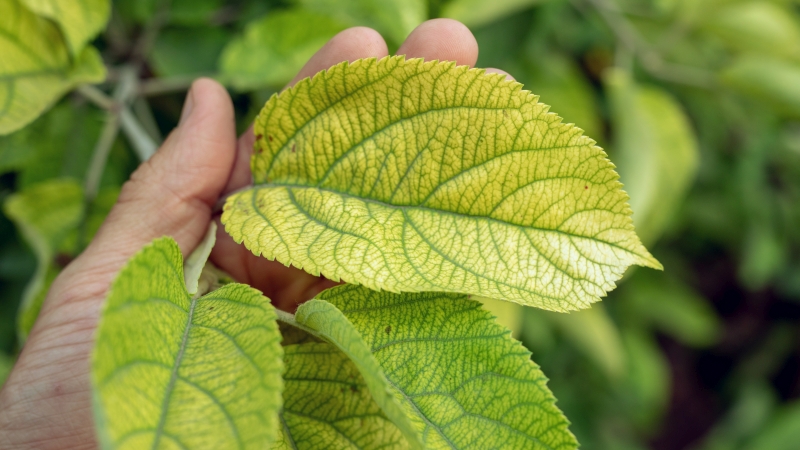Spinach Crop Down in the Dumps? It Might be Blue Mold

These leaves are showing angular chlorotic lesions caused by the pathogen Peronospora farinosa, the catalyst for downy mildew of spinach — also known as blue mold of spinach.
Photo by Gerald Holmes
Also known as downy mildew of spinach, blue mold of spinach is caused by the fungus-like organism Peronospora farinose f. sp. Spinaciae. The pathogen survives between spinach crops in and on dead spinach plants, crop residues, volunteer spinach and some weeds, and in infested seed.
Identification
Growers reported finding blue mold of spinach in Florida’s Everglades Agricultural Area (EAA) this spring for the first time in many years. While relatively uncommon in the EAA, blue mold is a common and often destructive disease of spinach in the other spinach production areas during cool, wet conditions. The presence of this disease in the Glades this spring may be a concern for producers further north in the Hastings area.
Downy mildew symptoms first appear as pale, yellowish spots with a grayish downy growth on leaf undersurfaces that turn purplish-blue as spores form. Infections may be scattered or numerous, but individual lesions often coalesce. Severely infected plants may be stunted or die. The disease can reduce both spinach yield and quality and can be quite damaging to susceptible cultivars. Sometimes the inner leaves of infected plants escape damage.
Survival and Spread
The pathogen is spread within and among fields by wind and splashing water droplets. Pathologists have identified at least four races of the downy mildew pathogen, but not all races are present in all production regions. The ideal scenario for disease development is a period of cool rain days with temperatures between 48°F and 54°F, followed by fog and/or a period of extended high humidity and dewfall with temperatures in the 60s.
Management Methods
Several blue mold-resistant varieties have been developed and should be employed if they meet production and marketing requirements. Growers should select varieties that match the prevalent pathogenic races in the production region.
Cultural controls for blue mold of spinach include use of a three-year or longer crop rotation to non-hosts such as sugarcane or corn. Growers also can strive to reduce prolonged periods of leaf wetness by increasing row spacing, orientating rows parallel to the prevailing wind direction, and avoiding overhead irrigation. Spinach blue mold typically subsides and disappears if the weather becomes warm and dry.
Promptly and thoroughly incorporate crop residues and volunteer spinach to reduce pathogen survival and overwintering. Since the pathogen is an obligate parasite, growers should plan a crop-free period in their rotation or locate new plantings well away from existing plantings to avoid carry-over of inoculum from one planting to another.
No biological control strategies are in place for downy mildew. Chemical controls are most effective when integrated with good, cultural control practices. Copper-based fungicides may leave unattractive residues on leaves and make them unmarketable.
Consult UF/IFAS recommendations for currently labeled fungicides for spinach downy mildew control in Florida.










